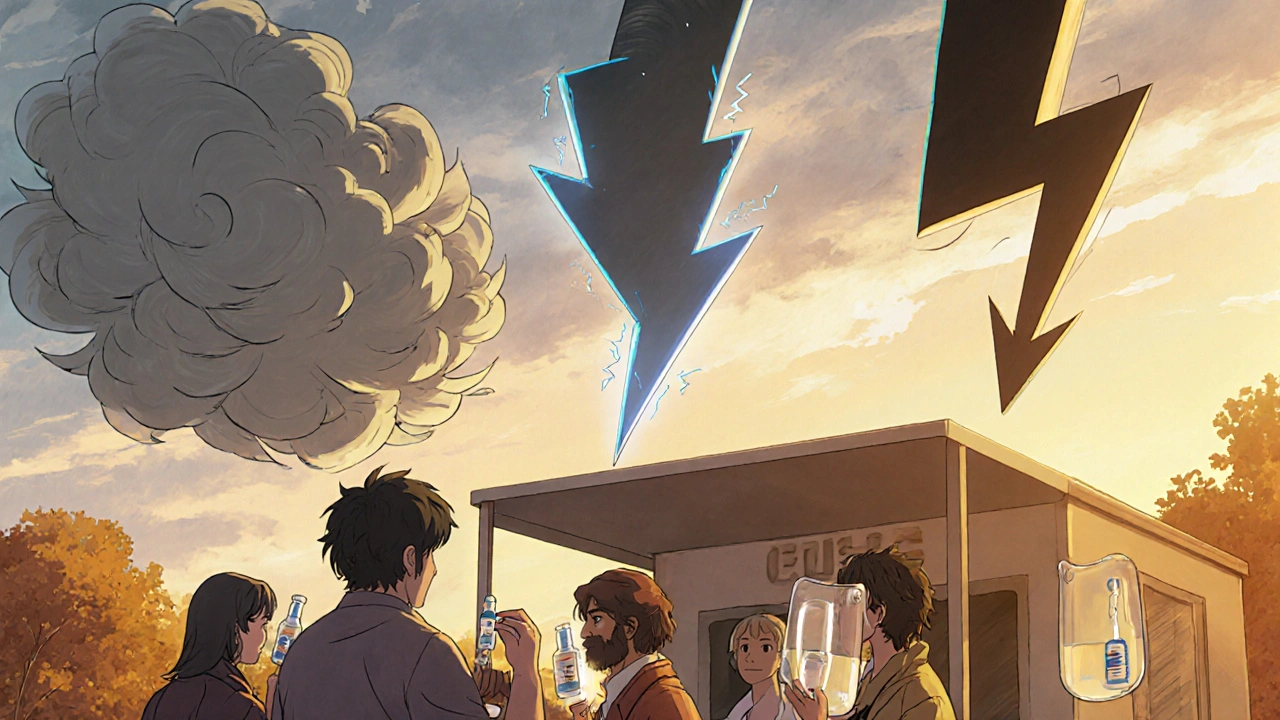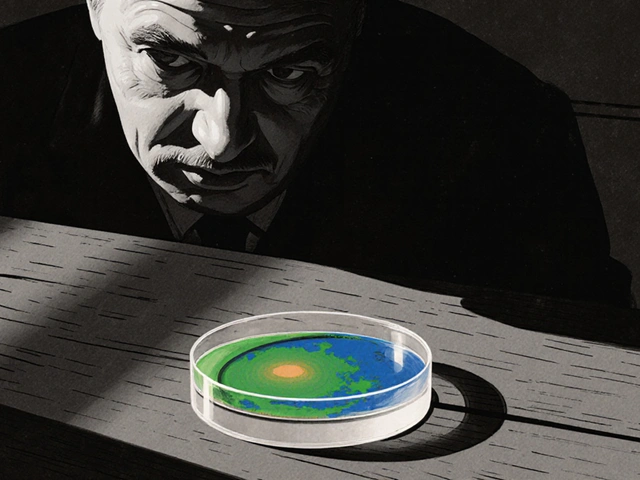What COVID-19 Feels Like Right Now
If you caught a cold last week and thought it was just allergies, you might’ve been wrong. The dominant variant in late 2025 is XFG, also called Stratus, and it doesn’t sneak up-it hits. People report a sudden sore throat that feels like glass shards, followed by congestion, headache, and muscle aches. Fever isn’t always there, but fatigue is. Some get nausea or diarrhea. It’s not the same as the early pandemic. You won’t lose your sense of smell for weeks, and you probably won’t end up in the hospital-if you’re vaccinated.
But here’s the catch: even if you feel fine, you can still spread it. The Stratus variant is more contagious than anything we’ve seen since 2021. And for some, the illness doesn’t end after a week. About 1 in 5 people still have symptoms like shortness of breath, brain fog, or insomnia three years after infection, especially if they were hospitalized. That’s not rare anymore-it’s expected enough that doctors now screen for long COVID at every follow-up.
The Variants You’re Actually Dealing With
The original Omicron? Gone. So are BA.5, XBB, and even the KP.2 strain that dominated last winter. As of October 2025, over 85% of cases in the U.S. are caused by XFG (Stratus). Another 7% are NB.1.8.1, and 3% are NW.1. These aren’t just numbers-they’re different versions of the virus with unique tricks.
One variant, called Nimbus, causes a sharp, stabbing throat pain that’s so distinct patients describe it as "like swallowing razor blades." It’s rare now, but if you get it, you’ll know. Stratus doesn’t have that signature pain, but it’s more likely to knock you out for days. It spreads faster, even among people who’ve had boosters. That doesn’t mean the vaccines don’t work. It just means they don’t stop you from catching it-they stop you from getting really sick.
Experts say we’re in a new phase. The virus isn’t disappearing. It’s adapting. Each new variant has a slight genetic tweak that helps it slip past immunity. But the immune system still remembers enough to fight off the worst. That’s why hospitalizations are down 17% from summer 2025, even though cases are high.
Which Vaccine Should You Get in 2025?
The 2024-2025 vaccines targeted KP.2. The 2025-2026 ones? They’re updated again. Pfizer and Moderna now target the same strain: XFG (Stratus). Novavax’s new shot targets JN.1, but lab tests show it also protects against Stratus and KP.3. You don’t need to pick the "best" one. All three work well. The CDC says anyone 6 months and older should get one dose this fall.
Here’s what most people don’t realize: the goal isn’t to prevent infection anymore. It’s to prevent death. Studies from Ohio State University show the vaccine is strongest in the first 90 days after getting it. After that, protection against infection drops. But protection against hospitalization? It stays above 80% for six months. That’s why experts say: get it now, even if you had COVID last month.
Side effects? Most people feel fine. A 2025 survey of over 1,200 people found 87% had no serious reactions. The most common? Sore arm (28%), tiredness (32%), headache (19%). One Reddit user wrote: "Got the shot in October, caught Stratus in November. Had a stuffy nose for three days. My unvaccinated neighbor was on oxygen." That’s the difference vaccines make now.

Treatment Options That Actually Work
If you test positive, don’t panic. You don’t need antibiotics. You don’t need steroids unless you’re struggling to breathe. For most people, rest, fluids, and over-the-counter pain relievers are enough.
For high-risk patients-those over 65, with diabetes, heart disease, or weakened immune systems-doctors may prescribe antivirals. Paxlovid (nirmatrelvir/ritonavir) is still the top choice. It cuts hospitalization risk by nearly 90% if taken within five days of symptoms. Molnupiravir is another option, though less effective. Both require a prescription.
Monoclonal antibodies? Most are outdated. The last ones that worked against earlier variants no longer help with Stratus. But there’s one exception: clesrovimab, approved in June 2025. It’s not for treating adults-it’s for newborns and babies under 8 months to protect them from RSV, which often hits at the same time as COVID. That’s why doctors now recommend flu and RSV shots along with the updated COVID vaccine for older adults and young children.
Who Needs the Vaccine Most?
Everyone 6 months and older. That’s the CDC’s official line. But some groups benefit more.
Older adults, especially those over 75, are still the most likely to be hospitalized. People with chronic lung disease, kidney failure, or cancer are also at higher risk. Pregnant women? They’re 3 times more likely to need ICU care if they get COVID. Vaccination during pregnancy also protects the baby for months after birth.
Healthcare workers? 99.3% of U.S. hospitals require them to be up to date. It’s not just policy-it’s survival. One nurse in Chicago told me: "I’ve seen three patients die this year because they thought they were fine. They weren’t vaccinated. They didn’t think it mattered anymore. It does."

Why So Many People Still Won’t Get the Shot
Despite the data, nearly 4 in 10 unvaccinated adults still say they’re worried the vaccine was rushed. That’s from a March 2025 CDC survey. Others say they’ve had COVID before, so they’re "immune." Or they think it’s "just a cold."
But here’s what those beliefs miss: immunity from infection fades. The virus changes. Last year’s strain isn’t this year’s threat. And while most young, healthy people recover fine, they can still pass it to someone who won’t.
Another problem? Confusion. Health departments update guidelines every few months. One week you’re told to wait 3 months after infection before vaccinating. The next, they say you can get it sooner. That inconsistency makes people tune out. But the core message hasn’t changed: get the updated shot every fall. It’s like the flu shot now. No drama. Just regular protection.
What’s Next for COVID?
Experts agree: SARS-CoV-2 is here to stay. It won’t vanish. But it won’t shut down hospitals or schools again either. Dr. Anthony Fauci predicted in July 2025 that COVID will behave like the flu-seasonal, predictable, manageable with annual shots.
By 2026, vaccine formulas will be chosen based on the strains circulating in spring and summer, just like flu shots. Prediction models are now 85-90% accurate. That means fewer mismatches. Fewer breakthroughs. Fewer hospitalizations.
Long COVID care is becoming part of standard medicine. Clinics now offer rehab programs for fatigue, memory loss, and breathing issues. Insurance covers them. Doctors screen for them. It’s not a footnote anymore-it’s part of the treatment plan.
The virus changed. Our response did too. We’re not fighting a pandemic anymore. We’re managing an illness. And that’s okay. Because we have the tools. We just need to use them.







